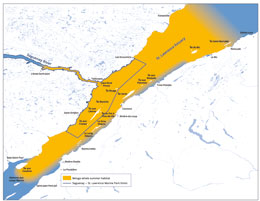Best Practices for Navigation around Beluga Whales in the St. Lawrence Estuary
If you see one or many beluga whales
1. Don’t try to approach them: KEEP YOUR DISTANCE.
2. SLOW DOWN and move away, keeping at least 400 metres between you and the beluga whales.
3. If a beluga whale comes near your vessel, SLOWLY MOVE AWAY with caution.
• In a boat: Don’t stop. Continue to sail until you are at least 400 metres away from the belugas, and maintain a constant speed between 5 and 10 knots. Avoid repeated changes of direction. If the 400 metre distance is impossible to maintain, stay the course.
• In a kayak: Don’t stop. Continue to paddle until you are at least 400 metres away from any belugas.
Remember that inside the boundaries of the Saguenay— St. Lawrence Marine Park, specific marine mammal observation regulations apply: marinepark.qc.ca

Show you care, keep your distance!
Vessels travelling on the St. Lawrence Estuary and the Saguenay River, in the heart of the St. Lawrence beluga’s habitat, frequently encounter beluga whales, in particular females with their calves. In fact, the boating season coincides with the period when females give birth, nurse and raise newborns. This is a critical period for the survival of young belugas.
Beluga whales need space and a peaceful environment
When beluga whales approach your vessel, they are reacting to your presence by changing their behaviour. Your presence can disturb their resting, feeding activities, even the birthing or nursing of their young.

Don’t forget that there are thousands of boats in the Estuary between June and September, during the beluga birthing season. All these disturbances can have an impact on the health and reproduction of beluga whales and on the survival of their young. This is why it is important to keep your distance.
A species at risk
In the 19th century, the beluga whale population in the Estuary and Gulf of St. Lawrence was estimated to be 10,000. It then declined because of hunting. In 1979, when hunting stopped, the population stabilized at about 1,000 individuals. However, since the early 2000s, it has been declining slowly at a rate of about 1% per year. Marine traffic, recreational boating and whale watching activities at sea can disturb belugas and hamper their recovery.
To report an incident
If you witness any activity or behaviour that is disturbing the belugas, please contact Poaching Alert at Fisheries and Oceans Canada on the Internet or at:
1-800-463-9057
Online Form
When a marine mammal is stranded, injured or entangled, you can alert the Quebec Marine Mammal Emergency Response Network:
1-877-722-5346

